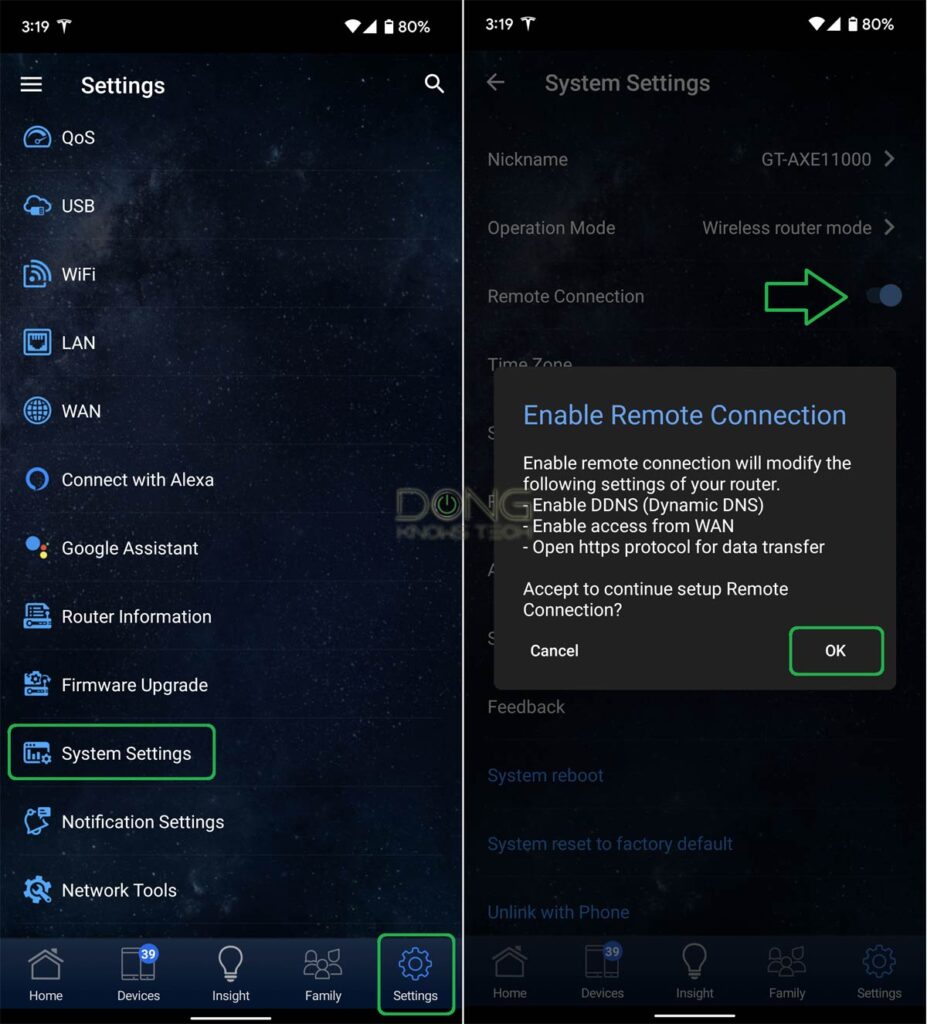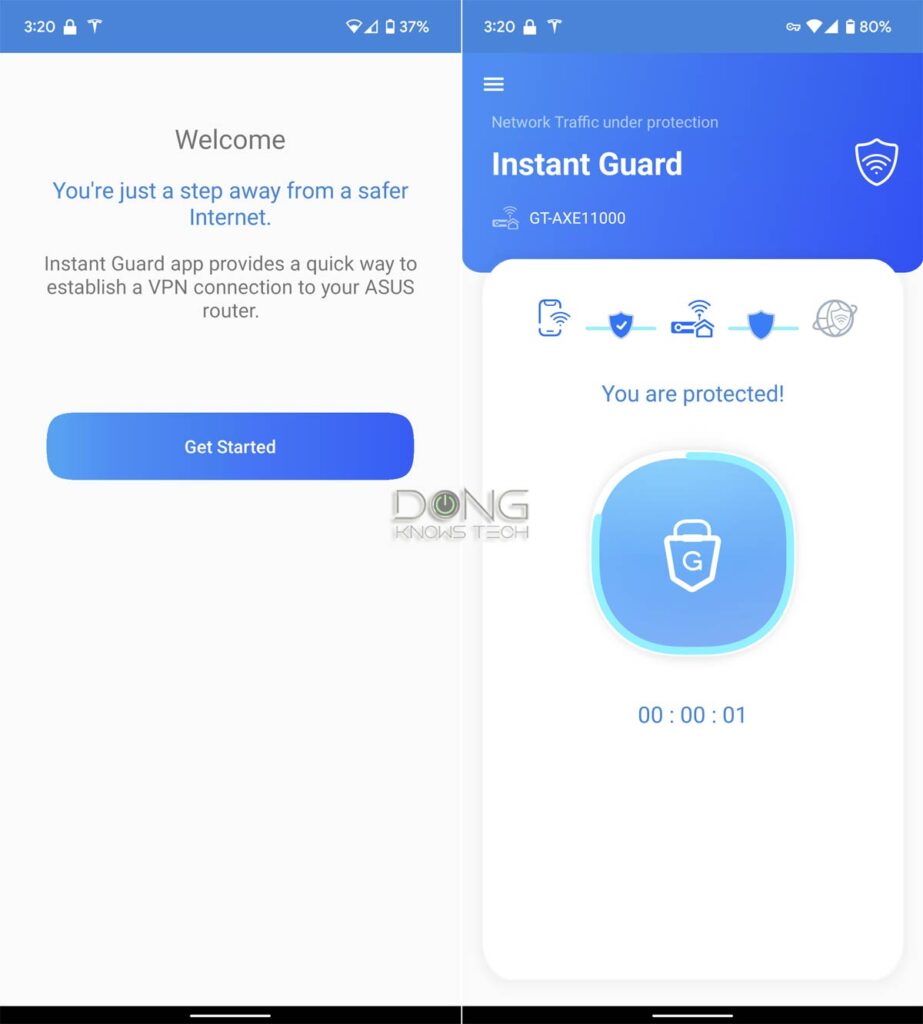Asus Instant Guard is an easy way to have a private VPN connection on your mobile device that’s linked to your Asus router at home. You’ll learn all about it in this post.
If you’re unfamiliar with what a VPN is, this post provides a detailed explanation. Before proceeding, ensure you’re comfortable with configuring a standard router through its web-based user interface.
Asus Instant Guard: Standard, no privacy risk, also easy to use
To use Instant Guard, you need to have an Asus router. Since mid-2021, most, if not all, Asus routers have supported Instant Guard, either right out of the box or via firmware updates.

Instant Guard vs. standard VPN protocol
If you own an Asus router, you might have noticed that it comes with a VPN section where you can set up one or more VPN servers. Note that Instant Guard, a VPN server in its own right, is separate from the router’s standard VPN protocols.
In other words, you can use a router’s standard VPN server, which supports all types of devices, as long as you know how to configure the client and Instant Guard at the same time. The key advantage of Instant Guard is that it works exclusively for mobile devices and doesn’t require any configuration on the router’s end.
That said, if you can make your phone or tablet work with the router’s standard VPN, Instant Guard is redundant—it’s not necessary.
However, if you’re a home or novice user who doesn’t have time to be technical, Instant Guard is a much easier alternative. Let’s find out how.
Instant Guard: Asus Router mobile app and single NAT are required
A couple of things to note on using VPNs with an Asus router.
First, all Asus routers come with a comprehensive web-based user interface and an optional ASUS router mobile app.
Secondly, regardless of whether you use the web UI or the app, all Asus routers utilize Dynamic DNS (DDNS) for remote management, which is necessary for the VPN to function properly.
The point is that you don’t need to register an account with Asus. All you need is a DDNS domain.
And speaking of which, as a bonus, each Asus router also comes with a free DDNS domain and an SSL certificate. However, you can use any other DDNS domain provider if you prefer not to have your router connect to Asus at all.

Generally, setting up a DDNS remote connection is involved and requires a certain level of networking know-how. However, if you merely want to use Instant Guard, Asus has made the process super easy as long as the following requirements are met:
Your router must be the only router in your home network—it must have direct access to the WAN IP. In other words, it won’t work if the router is working in the AP mode or you use a double NAT setup, where you use the router on top of another router.
These are the basic requirements for the DDNS connection to work. And while they seem like a lot, chances are that’s already the case in most homes, as long as you’re willing to ditch that ISP-provided gateway.
With that, let’s find out how to make Instant Guard work. Again, you do not need to do anything on the router other than the initial setup.
Steps to set up Instant Guard
Instant Guard is easy and straightforward to set up. Here are the detailed ABC steps:
A. Install and run the Asus Router App
- Ensure your mobile device, such as your phone, is connected to the router’s Wi-Fi network.
- Download the Asus Router mobile app on the device.
- Run the app, and it will prompt you to log in to the router using its admin password. Do it.
The password mentioned above is not the Wi-Fi password. If you’re not familiar with this, perhaps this entire post is a bit premature for you, and you should start with the one on home networking basics instead. Or this piece on home router security.
In any case, if you don’t know this password, you’ll need to reset the router and create a new one during the initial setup process.
B. Enable remote Connection
The screenshots below will help with this step.
- On the Asus Router app’s interface, tap on Settings, which is the last tab at the bottom.
- Tap on System Settings.
- Slight the value of Remote Connection to the On position (right).
- Answer the prompt affirmatively (OK).
The router will now enable the remote connection using Dynamic DNS.

Tips
This step effectively turns on the router’s DDNS feature and connects it to a randomly selected domain using Asus’s free Dynamic DNS service.
If you have set up the DDNS feature before, the app will automatically use your current setting, including when you use a third-party server.
Suppose you change the DDNS setting later, including using a new server. In that case, the Router app will automatically update its DDNS configuration as soon as you run it when you’re at home and connect to the router’s local Wi-Fi network.
C. Install and run the Instant Guard
On the same mobile device:
- Download and run the Instant Guard mobile app on the same mobile device.
- On the Welcome screen, tap on Get Started, and it’ll automatically log in using the settings of the Router app’s information.
- Tap on the shield icon to enable/disable the VPN connection.
Mission accomplished.

The takeaway
Asus’s Instant Guard is a streamlined version of a standard VPN. As such, it doesn’t cause privacy concerns but requires a standard network setup to work.
Specifically, it requires a network that supports Dynamic DNS. Additionally, the VPN only works for those who have access to the router’s settings, specifically the owner(s) of the router. So, it’s more restrictive in terms of who can use it.
However, in any case, Instant Guard is much better than using a third-party paid VPN service that requires you to pay for sharing your online data. That said, if you own an Asus router, it’s worth checking it out.



can Instant Guard be used when the Asus router is connected to Internet over 4G? Thanks
Yes, but generally, it’s not a good idea to use the router as a VPN server when your broadband source is cellular. It’s kind of pointless.
Hey Dong,
I see on my iPhone in Settings>General, there is a VPN section that allows me to configure a VPN on there. Would you recommend doing it this way (not using Instant Guard) with my Asus router, or would that subject me to Apple data gathering? Any issues you see with this?
Only the owner of the VPN server can spy on you, Ben. If you use your router — Instant Guard, Teleport, or a standard VPN — you’re the owner. As for the said VPN section, that depends on if you use Apple’s VPN or your own — there’re standard VPN server types on the router — more on VPN in this post.